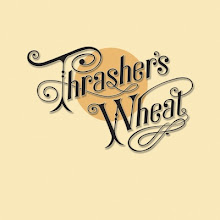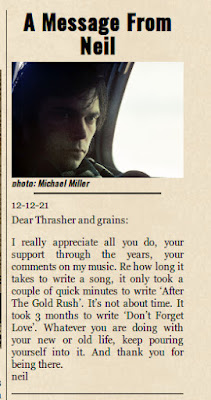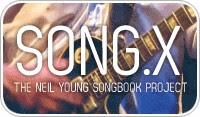Review: Neil Young - Chrome Dreams 2023
Here is a video review of Neil Young's latest album Chrome Dreams (2023) from Davy's Cinema Flicks & Music Picks.
Thanks Davy! Also, thanks on a bit of Ragged Glory Deluxe too.
More of Davy's reviews on releases 'Somewhere Under The Rainbow", 'High Flyin' ' & 'Molina, Talbot, Lofgren All Roads Lead Home'.
More on Chrome Dreams by Neil Young - UPDATED.
Labels: album, neil young, review


































 Human Highway
Human Highway

















 Concert Review of the Moment
Concert Review of the Moment





 This Land is My Land
This Land is My Land

 FREEDOM In A New Year
FREEDOM In A New Year









 *Thanks Neil!*
*Thanks Neil!*




![[EFC Blue Ribbon - Free Speech Online]](http://www.thrasherswheat.org/gifs/free-speech.gif)











 The Unbearable Lightness of Being Neil Young
The Unbearable Lightness of Being Neil Young Pardon My Heart
Pardon My Heart



 "We're The Ones
"We're The Ones  Thanks for Supporting Thrasher's Wheat!
Thanks for Supporting Thrasher's Wheat!




 This blog
This blog 
 (... he didn't kill himself either...)
#AaronDidntKillHimself
(... he didn't kill himself either...)
#AaronDidntKillHimself









































































 Neil Young's Moon Songs
Neil Young's Moon Songs




 Civic Duty Is Not Terrorism
Civic Duty Is Not Terrorism Orwell (and Grandpa) Was Right
Orwell (and Grandpa) Was Right


 What's So Funny About
What's So Funny About 



15 Comments:
CHROME DREAMS. Much is being made, understandably, of its songs’ existence on previous albums and collections. We do have to consider our respective currencies and the allocation of funds towards listening enjoyment. This is, after all, a $50 vinyl record we are talking about. And it’s not just the monetary value placed, but that of novelty. For those of us who never had the unofficial copy of Chrome Dreams, only two of the takes are new, and none of the songs are.
Yet this album as we hear it today is one of Neil Young’s finest works. I appreciate Davy’s highlighting of this observation. He does go into detail about where else all the songs can be found, but he also makes it a point to hold up the record as a stunning achievement on its own merits. The last thing we want is for this album to be derided as “Neil Young on shuffle”. This “previously released” paradigm is one that, having mentioned, I need to move past in order to hear this monumental album as it is, as it once was, in a world not unlike the one we know. What follows is one pathway toward that point of view…
NEIL YOUNG is “never second-guessing what could have been,” touts his record company as they promote the physical release of Chrome Dreams. Instead of second guesses, this long-awaited official version hints at the myriad of branching possibilities a form of expression might take. His albums have, since early days, included tracks from eras dating further back than the sessions at hand. Archival releases have expanded upon this conceit, unveiling entire projects previously lost to time. This has had a curious effect upon the devoted listener, taking familiar compositions and performances, placing them in a different context, and presenting us with multiple versions of the same reality. One result might be a “timelines” view of history, one in which two pieces cannot be reconciled to coexist.
A certain challenge now arises when taking in the discography chronologically, which has been exacerbated by the recent NYA catalog, particularly the Special Release Series. We are already accustomed to the Original Release Series; most of us have been at the record store experiencing at least part of this chronology in real time.
The ORS forms our first timeline. This is a world where Hitchhiker as an album never exists for almost anyone in the world, apart from the musician and his inner circle. Songs from that record were farmed out to later albums and compilations, the album itself dissolving somewhat through the process. It seems that although Neil had wanted to put Hitchhiker out as is, others had deemed it too rough and unfinished sounding.
Not to second guess, but to explore possibilities, what if Hitchhiker had been released back then? This almost certainly would mean a different Rust Never Sleeps, the key tape of Pocahontas featured there unlikely to have been revisited in this fashion. Our speculative exercise here hinges on the practice of each song made unique to a single album. For example, Pocahontas is on Rust Never Sleeps and only Rust Never Sleeps, because Hitchhiker and Chrome Dreams weren’t released. What might RNS have looked like without its three songs originally intended for Hitchhiker, and would it have existed at all? A separate timeline is formed in our perception where Hitchhiker is an album and RNS is not.
Another SRS, Homegrown, does not preclude the existence of Rust Never Sleeps. The two share no songs. Due to its final two songs, however, Homegrown does interfere with the track listing of American Stars ‘N Bars, as well as with Hawks And Doves a few years later. A couple other Homegrown songs also came out in different forms later.
Therefore, as of 2020, two distinct timelines exist: the ORS timeline, where albums were released as intended, and the H/H timeline, where intended albums Homegrown and Hitchhiker were actually released at the time. These two albums can coexist on a timeline; they share no songs, and there’s nothing saying Neil wouldn’t have put out Hitchhiker in a world where people already had Homegrown on their shelves. Following the release of Hitchhiker, some other combination of tracks from mid to late 70s sessions would have been compiled into a new record and some version of Decade. From there, the discography as we know it would have deviated further, at the very least significantly altering releases from 1990 and 2010.
How could Homegrown have happened in 1974? Its public release may have occurred as an act of the artist exercising his will. Neil decides that, despite the personal, painful nature of Homegrown, it’s worth putting out as planned. (I do hold that Tonight’s The Night could only have come after Homegrown, since its definitive artwork quotes the earlier, lost album.) And Hitchhiker? Perhaps Neil threw his weight around the boardroom, demanding Reprise stand behind it in 1976.
Now, with these two timelines already situated in our perception, enters Chrome Dreams. Let us ignore the bootleg acetate aspect for the time being (although, granted, it does have a real impact on our view of the era) and only concentrate on the officially released versions, since we are focusing on the artist’s intention and the possibilities within that depend upon choices made at important moments.
The entry of Chrome Dreams into the listener’s consciousness creates a third timeline. So many songs from the H/H tracklists are utilized here, there’s no possible way Chrome Dreams could have been released alongside these two albums. And of course it can’t hang on the Original Release Series timeline, since RNS and AS’NB would be so radically changed had Chrome Dreams seen the light of day. It could have followed Zuma no problem, but everything after would be completely different. Even Comes A Time and Freedom would have been affected by its existence.
So, Chrome Dreams optimally lives in its own discrete timeline branching off from the ORS, which is where I would like to place my mindset when listening. This eliminates the barrier to enjoyment presented by the understanding that nearly all of these songs can be found elsewhere in the ORS studio album selection. It’s a cure for that “we already have this” feeling that blunts the album’s effect as a work all its own.
Taken from this perspective, let’s accept Chrome Dreams as a three-sided record, as it is presented to us now. Sure, the bootlegged acetate may have been a single disc, but that pressing would have compromised the fidelity of the sound. Let’s hear it as the sum of sides 1, 2, and 3, in a format made possible by the present day while freed from any “previously released” constraints of the timelines we inhabit.
Chrome Dreams is introduced by the simple strummed pattern of Pocahontas, a primed canvas for the imagery that begins with “aurora borealis…” a cosmic signpost indicating dreamt possibilities ahead. Enough has been said of the song Pocahontas over the years that not too much analysis is called for here except to appreciate this legendary composition in the context of Chrome Dreams: no gloriously trippy overdubs, no audio-verite spoken intro, no full-band electrified churn. Just plainspoken storytelling, folksy and introspective speculative fiction accompanied by the woodsy reverb of Indigo studios. The what-if structure places the singer in a pre-chrome scenario, and we remember that the record came to be in a world where at least two of his albums were already “lost”. Was he dreaming of these albums as he placed Pocahontas first?
A similar aura surrounds Star Of Bethlehem, which ends Side 1 as celestially as
Pocahontas began it. It’s easy to imagine Neil considering Homegrown wistfully as he kisses off the unreleased LP with a single song that seems to say it all. Star Of Bethlehem and its all-star arrangement was meant to close out Homegrown; now it closes out the first side of Chrome Dreams, one chapter complete with so much more yet to come.
These two “lost” bookends frame one of the album’s major centerpieces: Will To Love. What a strange and epic treatise on the singer’s state of mind around this time. He’s been hurt, and he’s done some damage of his own. But he’s resolute in retaining what he values most in himself. This song was always meant to be featured prominently: not to define a record as the side’s opening track, but to stand strong as the very next statement. Absolute beauty, truly moving.
The ranch romance alluded to earlier is now given full attention on Side 2, Neil Young and Crazy Horse returning from Zuma starry eyed and sea-blasted. Here’s another old favorite given new life through resurrection of its original placement. There is an exhilaration in dropping the needle into Like A Hurricane in media res unlike any other presentation of the song. The second part of Chrome Dream splashes down in the middle of the storm, and we try to keep our heads above water as waves of Old Black and polyphonic Stringman wash over. Knowing by heart all the different Hurricane versions, we realize now that Chrome Dreams has always hosted the decisive placement of one of Neil Young’s most iconic creations.
“You could have been anyone to me”: more possibilities. The next song responds with a look back and a question: Was I too far gone for you? It’s a good question. Quick note on this one- they say Poncho didn’t know how to play the mandolin at the time of this recording. But it sure as hell sounds to me like he knew how to play it.
We’re at the halfway mark now, and we have arrived at something of a rarity, the solo rendition of Hold Back The Tears. This song functions beautifully as a continuation of the album’s acoustic center, and it reminds us that Neil was mastering the art of the studio, having recently completed Will To Love as an augmented solo performance and further developing this technique on Hold Back The Tears. The effect here is less striking than on its earlier counterpart but more refined, and the Spanish-tinged melody deftly restates the heartache motif of the album’s first half.
Side 2 closes out with Crazy Horse’s Homegrown, which also closed out Side 2 in the ORS timeline version of this record, American Stars ‘N Bars. We are really saying goodbye to the old Homegrown album here, with the Horse taking over duties and capping off their second side contributions with a laid-back canter. Its proximity to more stripped down country fare on Chrome Dreams does this crunchier Homegrown right. The song is also a refreshing palate cleanser, since things are about to get a little heavier on Side 3.
Up to this point Chrome Dreams has been mostly narrator driven, the characters people from his life, their importance to the song the role they play for him. The love interests in WTL, LAH, and TFG are examples of this type of supporting character who reflect the narrator’s romantic observations. Side 3 is a big departure from this focus. Most of its songs revolve around specific characters that seem to have been dreamt up by the singer. Likewise, its themes depart substantially from the passion and lost love that dominated the first two sides of Chrome Dreams. Now we are talking war.
Captain Kennedy makes his earliest appearance here. He hasn’t been relegated to a “hodgepodge” position halfway into Hawks And Doves, and he’s not one more great tune in a solo studio set. He is a key figure of the Chrome Dreams mythos, introducing the game-changing third part of Neil Young’s lost 1977 saga. Captain Kennedy is unsure of his abilities, and he is trapped in the destiny I to which he was born, following in his disgraced father’s footsteps. One gets the impression that despite his hope that he can “kill good”, he’s not going to make it out alive.
Rumination on the effects of war on a man’s identity continue uninterrupted with Stringman, whose sarge has been displaced by social change. His soul is likely the one Neil says is gone, along with those of the lovers on the blanket. This analogy brings the war home in a way that is too complex to fathom rationally. Stringman then becomes personal as Neil sings for a friend of his, applying the pain of these distant characters to someone he clearly cares about.
After all these years living as a Neil Young fan in the ORS timeline, it’s a heavy realization to discover that Captain Kennedy and the sarge of Stringman have been standing side by side all along. But we’re not even done contemplating the pain of war. Our poor young protagonist, Powderfinger, is faced with it before he’s ready. He does the best he can in a violent situation that is out of his control. We suspect he doesn’t make it out alive, but through the possibility of song, his story has made it through. On Chrome Dreams, his end is foreshadowed by the uncertainty of Captain Kennedy as he too heads into war.
Into this suite of wartime meditations slips Neil Young’s most nihilistic character, the Sedan Delivery guy. He is right at home among these lost and doomed souls. We can hear that he’s in over his head, but he hasn’t begun to admit it to himself. There’s a good chance he never will. Through his chaotic, insular, jaded worldview, he has drummed up only dark possibilities for his own future. He may have eschewed the “boats and armies” favored by Caesar and Cleo, but he’s embraced the dead end of war all the same through the titular job that he knows he’ll keep.
Before long, Crazy Horse will take Sedan on the road to deliver at breakneck speed. But they don’t know that yet. For now, the early Zuma track rattles along, boiling over with effected menace. And having featured one of the first times these four guys would ever record together, Chrome Dreams finishes eerily with Look Out For My Love, a standout track that sticks out like a sore thumb on Comes A Time the following year. Acoustic, the Horse brought the spook with them this time, and LOFML fits Chrome Dreams perfectly as its closing statement. Impressionistic, mantra-like, simultaneously foreboding and hopeful, it leaves us with the sense that anything could happen next.
Finally, etched into Side 4 is an image so perfect in its simplicity that it evokes an almost totemic cohesion, pulling the disparate sessions together into a whole, Chrome Dreams finally realized as a tangible item fifty-some years after the fact. In fact, the art of Chrome Dreams speaks to the “lost” aspect of the album as well as to its inherent immediacy. The paper sleeves resemble the old acetate that was photographed to be circulated with the beloved bootleg. On the back is an old prototype handwritten tracklist with alternate songs considered. The cover drawing by Ronnie Wood is era-appropriate, and thematically fitting, as we recall that David Briggs’s original “Chrome Dreams” artwork is truly lost. What a fortuitous boon, that long gone sketch somehow replaced by this 1976 penciled depiction of Neil Young, dreaming away into the chrome.
My take:
https://everybodysdummy.blogspot.com/2023/08/neil-young-68-chrome-dreams.html
good takes from Tomatron & wardo.
Comments of the Moment?!
Comments of the moment indeed! Fabulous viewpoints. At the start of Tomatron's writing he mentions the costs to the individual and the fact that the songs are already out there. It's all relative to each of us of course, but I'm slightly struggling with this one on a value for money issue. Believe me, I want to buy it (on CD), I've bought every Neil release for over 30 years, but why on earth is this one so expensive? I buy from my local record shop as much as possible, and the figures I'm about to quote are all based on purchases from there on the day of release of the albums named, so as to show the weirdness of the pricing of Chrome Dreams. In the last year, World Record, 2cds, £17/$22. Somewhere under the Rainbow, 2cds, £16/$20.50. The Ducks, 2cds £14/$18. Chrome Dreams, ONE CD!, £19/$24.25......next to Chrome Dreams on the new releases rack was a Bowie / Ziggy Stardust 50th anniversary set that was made up of 2cds and a blu ray, all for £21/$27.....2 major artists on major labels.....go figure...
Old Black, it’s excellent that you’ve been supporting local shops when picking up your physical releases. My hope has been to argue for the value of the album on vinyl specifically. When trying to justify the price, I would not recommend Chrome Dreams on CD, it’s not worth it. Upwards of $20 for inferior resolution and miniaturized artwork? We can get higher audio fidelity with streaming, at a more economical cost. All the artwork, credits, etc. is available on NYA. And there we have the ability to create playlists. For example, I can listen to a deluxe edition of Chrome Dreams where I added White Line and Lotta Love as bonus tracks. So I would recommend any Neil Young fan, casual or devoted, who owns a turntable, invest the fifty bucks and get the LP version. Each album side is a major statement. Not into vinyl? Unlimited data and a reasonable subscription fee = endless enjoyment! For me, both are necessary. I have my records in the living room and NYA everywhere else.
thanks again for comments an reviews!
as we -- and many -- have observed, Neil Young has more ‘lost’ albums than most artists have "found" albums.
http://neilyoungnews.thrasherswheat.org/2023/08/reviews-of-chrome-dreams-2023-by-neil.html
Thanks for the kind words Tomatron!
I try on these to review from two perspectives - the guy who idolises Neil Young AND the guy who reviews all sorts of other things too. As you say, money isn't growing on trees so I think it's important to say "OK, this may not be an urgent pick up for you if you have X, Y and Z and don't have a romance with the notion of the great lost albums". And at the same time not downplaying the wonderful nature of what this is.
I DO think had this come out before or instead of Hitchhiker, even Homegrown (both still would be in the Archives II box, of course) it would be getting a lot more love from a wider group. Ditto the Odeon Budokan release on vinyl. While we all love this material, I think more could be done from Neil's side to help it cross over a lot more. I am not alone in having loads of friends ask me "What's this one? Is this good sound, that Rainbow one wasn't? Why is the Bootleg Series different to the Performance Series?" etc etc.
A little bit more curation would help.
Tomatron, thanks for your advice, much appreciated, and for your fantastic review by the way. My point wasn't to try to weigh up the pros and cons of vinyl versus cd versus streaming based on what each format costs, each to their own there etc, but to highlight the bizarre pricing of the cd's only, which seems totally random and hugely out of sync with what other record labels (not the artists, so I've been informed by my record shop) are charging for a similar product. There's no disputing however just what a fabulous selection of songs Chrome Dreams is made up of though!
Thanks, Thrasher! Hey Davy and Old Black, great hearing from y’all! I meant to respond sooner, but the system kept bouncing my profile back and I couldn’t post anything for a while.
There are so many frameworks now in which to experience these songs, context matters more than ever. For instance, I feel Star Of Bethlehem’s placement on Homegrown and Chrome Dreams are equally crucial, while its inclusion on Decade has somewhat less relevance today. In fact, I’m unlikely to spin Side 2 of American Stars ‘N Bars at all now that Chrome Dreams has been manifested. Suddenly Side 1 of AS’NB is that album’s sole use!
Chrome Dreams on vinyl is so good, I think it might be my first recommendation to anyone looking to begin with Neil Young’s discography. Even though it’s a little bit weighted toward the acoustic side, all the songs are phenomenal, and the electric tracks are prime Horse, no question. And the gentler songs hold up heavy enough; they’re tender without being very sappy at all. Although the themes get dark, especially on Side 3, I don’t even think the overall tone is too “down”, it’s more hopeful as a whole than, say, Tonight’s The Night or On The Beach.
As to the pricing question, I’d agree, those are some strange list prices. It’s a weird time for the record industry; this feels like an experiment to see how the big companies can turn their profit in the world of music and movie streaming prevalence. And we do have quite the slew of random NY albums hitting the stores. The discography is, indeed, messier than ever, and that’s saying a lot by Neil Young standards. The cognitive dissonance between Hitchhiker and Chrome Dreams, in particular, is probably what spurred on the whole “timelines” categorization, just trying to mentally reconcile these albums’ consecutive shelving. Like, they both start with the same take of Pocahontas, but one has an offhand intro?? Then the records go off into completely different directions. But isn’t this very chewiness contributing to our collective obsession with the catalog? At least we have the NYA file cabinet to pore over and try to make sense out of it all.
Post a Comment
<< Home